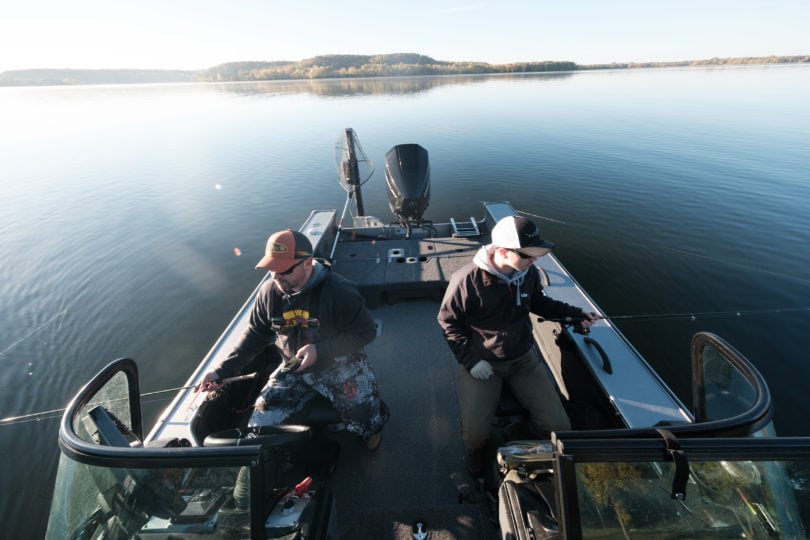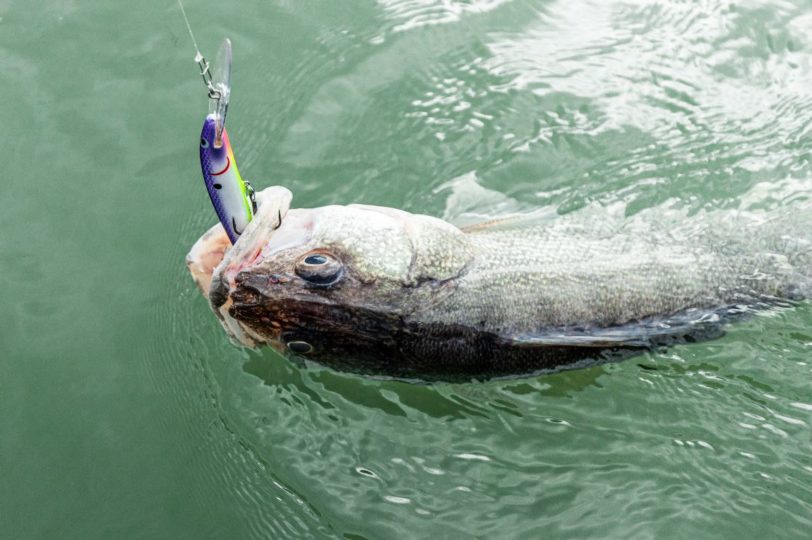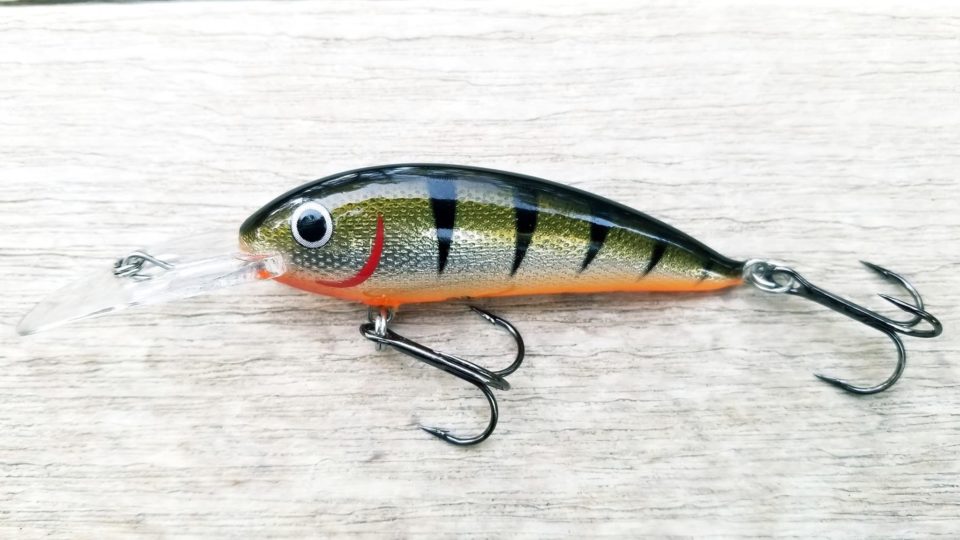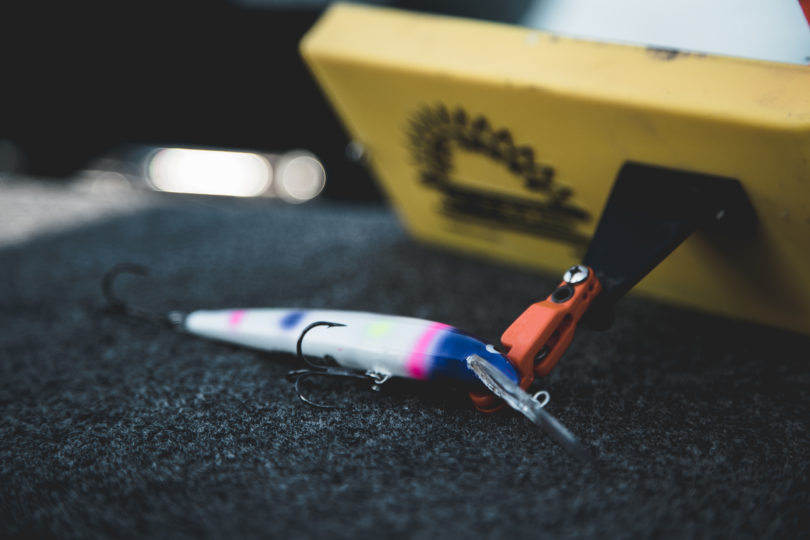Trolling balsa baits could be the number one tactic for getting all kinds of fish to eat, during any open-water season of the year. Whether long-lining on braid or raiding the depths behind some leadcore, the Northland Rumble Series Baits are made to elicit reaction bites while withstanding everything from heavy cover to vicious strikes. That durability and “fishiness” are on display each time you put a Rumble Series Shad, Shiner, or Stickbait behind the boat. That said, here are some summer trolling tips to help you get bit with greater regularity. Here are a few items to take into consideration the next time you’re pulling a Rumble Series Crankbait.
Depth – Especially for bottom-dwelling fish like walleyes, dive depth could be one of the first variables to tackle when considering which Rumble Series Bait to pull. Different series run differing depths with the Rumble Stick diving deepest, the Rumble Shad patrolling moderate depths, and the Rumble Shiner running shallowest. However, within each of those models are different sizes, which each have its own running depth. That makes it possible to cover some depth ranges with multiple baits of differing sizes.
Electronics – It’s best to pull over fish that you’ve already found, so putting in some time with your electronics will help set up your trolling run rather than going in blind. Use a combination of side-imaging, 2D sonar, and down imaging to locate schools of fish you’d like to target, then drop some waypoints on the largest or most consistent clusters. In open basin scenarios, that may be bait pods with suspended feeding fish. On shoreline breaks, that could be a weed-edge with features that attract bait and resulting fish. Mark your milk run, then execute it.
Structure – Not all structure is conducive to pulling crankbaits. When long-lining, we’re talking about large features with relatively consistent depths. That’ll help keep your baits in the zone and in front of fish for the longest time possible. Scattered fish along large structural elements are much preferred over tight pods of fish on small rock piles for example. You want your bait to be live for miles, not meters, anytime you put a Rumble Crank back behind the boat.
Boat Speed – Conventional wisdom has most people pulling crankbaits in 2.2mph – 2.8mph GPS speeds. That’s not a hard and fast rule, however, as wind and low-light will allow faster speeds which should be interpreted as more water covered. Bright conditions or neutral fish in deeper water may like it a little slower, all the way down to 2.0mph. The key point to realize though, is that boat speed affects dive depth, so whatever combination of crankbait model and size, paired with line behind boat, depth, and speed, should be remembered to replicate any success you may find.
Boat Control – This could also be referred to as depth control, which means keeping your crankbaits just above the bottom and on a consistent track. S-curves can be useful to trigger fish into biting but can be tricky, especially with leadcore. Baits that repeatedly dredge bottom or are fouled, can start to roll and make their way to other lines. A good driver monitors electronics, drops waypoints, and keeps baits from being tangled by keeping a good track that avoids other boats, cover, and water that’s too shallow.
Line-Counter Reels – Line counter reels are crucial when cranking to be consistent with your sets. Typically, there’s a “magic” combination that results from proper depth, speed, and bait – but all of them are dependent upon the amount of line back behind the boat. Too little and the bait won’t achieve its full diving depth. Too much and you may be fouling on the bottom, though there are times in clear water where lots of line out can have its advantages. The bottom line is that you need to experiment with different amounts of line out per reel at first, catch some fish, then replicate success on all reels in the boat.
Line Choices – For most anglers, simple mono is a great material to pull crankbaits on, as it’s forgiving with a fair amount of stretch. That’s also its downside, so it can be more effective to pull crankbaits on a braided line type. A better feel of the bait’s “wobble” will ensure your Rumble Series Crankbait is running true without weeds or other fouling, and less stretch afforded by braid means a positive response when trolling. Of course, this can be too much of a good thing (see Rod Considerations below). Leadcore trolling employs a special line type on a line counter reel that’s hollow in the center and filled with a single strand of lead. That lead sinks the line and brings the bait to deeper diving depths. In this scenario, it’s often wise to let line back until you’re hitting bottom, then reel up a few turns such that you’re only randomly ticking bottom from time to time. For walleye especially, this is important. Because of the bow in leadcore line, keeping consistent depth, trolling speed, and bait types employed will be paramount to your success.
Leaders – In ultra-clear environments, especially for open water basin trolling, fluorocarbon leaders up to 30’ may be employed. In river systems with sharp rocks or zebra mussels, it can be wise to use nano braid style leaders to stand up to the abuse. Most often, fluorocarbon wins out, offering a few feet of invisible connection to your baits.
Rod Considerations – It’s important to utilize a slower action rod with more of a parabolic bend to it when pulling crankbaits. These are often inexpensive rods, but especially on hard lines like braid, the effect is crucial. Slower actions allow fish to get the baits completely in their mouths before tension slowly drives those hooks home. A fast rod with a braided line simply results in more fish lost, despite sticky hooks and lots of them.
Snap – Snaps are simply the best way to run your crankbaits, no matter what style you’re pulling. Easy open and close wire offers quick changes between baits, and perhaps more importantly, the large wire loop at the end allows for maximum travel when the bait wobbles side to side. You could tie each bait directly, but you’d have more work into each bait change, and less action to show for it.
No matter where you troll crankbaits, they’re effective tools for both finding and catching fish. There are many times when starting off on a new lake, especially on big water, that crankbaits should be your first and primary consideration. Covering water and finding active pods of fish can help inform you of new spots, and better techniques to target them too, allowing your reconnaissance to be often as productive as your end-game strategy.
When the time comes to dial in that trolling bite and the Rumble Stick is your selected balsa crankbait, be sure to check out this detailed video on Rumble Stick trolling tips.





